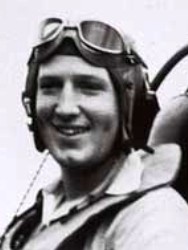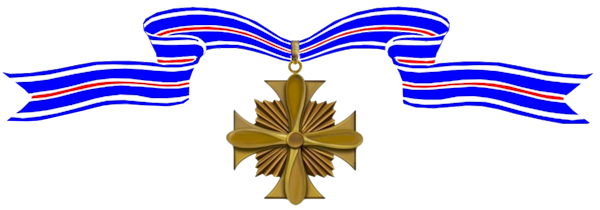William Andrews was credited with shooting down four enemy aircraft in aerial combat during World War II.

Home:
,
Awards Received
-

Distinguished Flying Cross
-

Distinguished Flying Cross
-
Distinguished Flying Cross
Service:
United States NavyRank:
EnsignBatallion:
Fighting Squadron 31 (VF-31)Division:
U.S.S. Cabot (CVL-28)Action Date:
June 11, 1944
The President of the United States of America takes pleasure in presenting the Distinguished Flying Cross to Ensign William George Andrews, Jr. (NSN: 0-264176), United States Navy, for heroism and extraordinary achievement while participating in aerial flight as a Pilot in Fighting Squadron THIRTY-ONE (VF-31), embarked in U.S.S. CABOT (CVL-28), under fire on 11 June 1944, during the invasion of the Marianas. Despite the fact that he was under heavy return fire from enemy fighters, who scored a number of hits on his plane, he courageously and with complete disregard for his own safety pressed home his attack, shot down one Japanese fighter and damaged three more planes on the ground by strafing, ignoring severe damage to his own aircraft. He then made a successful landing without flaps on his base carrier. His courage and skill throughout were in keeping with the highest traditions of the United States Naval Service.
-
Distinguished Flying Cross
Service:
United States NavyRank:
Lieutenant, Junior GradeBatallion:
Fighting Squadron 31 (VF-31)Division:
U.S.S. Cabot (CVL-28)Action Date:
September 22, 1944
The President of the United States of America takes pleasure in presenting a Gold Star in lieu of a Second Award of the Distinguished Flying Cross to Lieutenant, Junior Grade William George Andrews, Jr. (NSN: 0-264176), United States Navy, for heroism and extraordinary achievement while participating in aerial flight against enemy forces as the pilot of a single-seater carrier-based fighter plane in Fighting Squadron THIRTY-ONE (VF-31), embarked in U.S.S. CABOT (CVL-28). On 22 September 1944, in the vicinity of the Philippines he participated in an early morning fighter sweep against a highly important enemy-held airfield. In the face of a substantial amount of anti-aircraft fire he courageously made a low-altitude bombing attack and skillfully scored a direct hit on an enemy anti-aircraft position adjacent o the airfield. Afterwards his group encountered a formation of six enemy planes. He daringly attacked the formation and succeeded in shooting down two of them, one of which, at great risk to his own life, he chased in and out of numerous clouds a distance of fifteen to twenty miles. His skill as a pilot, coolness and gallantry have contributed materially to the splendid record established by his squadron and have at all times been in keeping with the highest traditions of the United States Naval Service.

